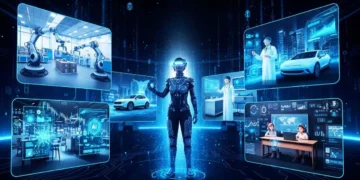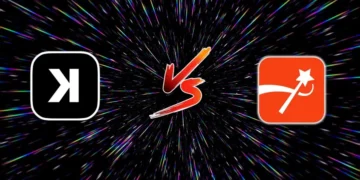In the rapidly evolving landscape of global finance, two technological titans are colliding: the decentralized cryptocurrency revolution led by Bitcoin and the transformative power of artificial intelligence. As AI reshapes industries from healthcare to finance, a critical question emerges: Can Bitcoin maintain its relevance as “digital gold” in an AI-dominated future? This isn’t just theoretical—the answer could determine the future of your investment portfolio and how we conceptualize value in the digital age.
The emergence of potential National Bitcoin reserves and recent Deutsche Bank Bitcoin Fed predictions signal shifting institutional attitudes. Meanwhile, AI continues to infiltrate financial systems, optimizing trading, risk assessment, and even monetary policy. Understanding the intersection of these powerful trends is no longer optional for serious investors—it’s essential for navigating the financial landscape of tomorrow.
The evidence of AI’s disruptive power is already staggering. AI tools now handle approximately 89% of global crypto trading volume, with AI agents surging to a $31 billion market cap and consistently outperforming manual trading strategies by 15-25% . Meanwhile, Bitcoin miners—the essential workforce securing the network—are increasingly abandoning their operations to pursue more profitable opportunities in the AI computing boom . This migration raises fundamental questions about Bitcoin’s long-term security and viability.
Yet Bitcoin has repeatedly demonstrated remarkable resilience throughout its 16-year history. Its decentralized design resists the centralized control and inflation common in fiat currencies, while its fixed supply of 21 million coins creates scarcity that attracts those seeking protection against currency devaluation . The crucial question we’ll explore is whether these inherent strengths will be enough to withstand the most powerful technological force of our generation.
Understanding the AI Impact on Bitcoin Price and Adoption
Artificial Intelligence (AI) is changing everything from financial markets to everyday transactions—and Bitcoin is no exception. Recent studies reveal that AI-driven investment strategies outperform traditional approaches, achieving returns multiple times higher than conventional buy-and-hold methods. For instance, an analysis of Bitcoin’s price from 2018 to 2024 showed an AI-based strategy yielded returns over 1640%, vastly surpassing passive strategies.
AI’s influence doesn’t stop at price prediction. With AI-powered analytics, traders and institutional investors gain enhanced foresight into market trends, enabling more informed investment decisions. The AI and Bitcoin revolution also introduces innovative use cases such as decentralized AI marketplaces and smart financial contracts that adapt in real-time to market conditions.
Ask yourself: How much do you trust AI’s role in predicting Bitcoin’s next moves? Have you integrated AI-driven tools into your investment toolkit yet?
How Blockchain Enhances AI Accountability and Trust
One of AI’s biggest challenges is accountability—many AI models operate in what experts call an “epistemological vacuum,” lacking verifiable proof of their reasoning processes. Blockchain technology addresses this critical gap. By linking AI operations to an immutable ledger, blockchain adds transparency, traceability, and trustworthiness to AI decision-making.
Breakthrough platforms like Teranode are pushing the boundaries by offering blockchain scalability capable of processing millions of transactions per second (TPS). This capacity enables seamless integration of AI with blockchain for instant, verifiable settlements—the backbone for next-generation AI-powered financial services.
Can you imagine a future where every AI decision you rely on is logged and verified on an immutable blockchain? This symbiosis is not just theoretical but rapidly becoming a reality.
Bitcoin’s Meteoric Rise: From Obscurity to Institutional Darling
Bitcoin’s journey from cryptographic experiment to legitimate asset class represents one of the most remarkable financial stories of our generation. What began as a niche interest for cryptographers and cypherpunks has evolved into a global phenomenon with over 562 million users worldwide—that’s 6.8% of the global population who now own cryptocurrency .
The Institutional Adoption Timeline
Bitcoin’s path to legitimacy has been paved with significant milestones:
2009-2012: Early mining phase where pioneers like James Howells mined “400-800 Bitcoin intermittently overnight for two months” on a standard laptop
2013-2016: Initial price discovery and early exchange development, though still dominated by retail investors
2017-2020: Futures market development and growing institutional interest despite volatility
2021-2024: Corporate treasury adoption and sovereign recognition, with countries like El Salvador making it legal tender
2025-Present: Spot Bitcoin ETF approvals and serious discussion around U.S. strategic Bitcoin reserves, marking the maturation phase
This evolution reflects a fundamental shift in perception. What was once dismissed as “rat poison squared” by legendary investors like Warren Buffett is now considered a “critical hedge” against fiat debasement by established financial institutions like Jefferies Financial Group .
Global Adoption: Beyond the Hype
The narrative around Bitcoin has transformed from speculative asset to practical financial tool. Recent data reveals that:
80% of crypto owners are interested in using cryptocurrency to purchase daily retail goods
65% of crypto owners want the option to pay with cryptocurrency when shopping
56% would choose a store that accepts crypto over one that doesn’t
This isn’t just theoretical—global crypto merchant adoption grew by 48.6% in just one year, with over 16,350 businesses worldwide now accepting cryptocurrency . Countries like Brazil lead with 1,781 crypto-accepting businesses, while El Salvador ranks third with 1,166 merchants, surpassing developed economies like Germany and the UK .
The AI Revolution in Finance: More Than Just Algorithms
While Bitcoin has carved out its niche as digital gold, artificial intelligence is quietly rebuilding the financial infrastructure around it. AI’s influence extends far beyond algorithmic trading—it’s reshaping risk assessment, fraud detection, customer service, and even regulatory compliance at fundamental levels.
Nvidia’s Rise and the Innovator’s Dilemma
The AI hardware sector, led by Nvidia, has seen astronomical growth, briefly pushing the company’s market cap above the $5 trillion mark . Yet this dominance faces significant challenges that could impact AI’s financial revolution:
The competitor threat: Major customers like Alphabet, Amazon, and Microsoft are designing their own AI chips
Supplier diversification: OpenAI’s recent deal with AMD for AI chips signals a shift away from single-supplier dependency
Valuation concerns: Nvidia’s P/E ratio “floating just south of 56” assumes continued hypergrowth in a increasingly competitive market
As one analyst notes, “Nvidia faces a classic innovator’s dilemma… When you’re trading at nosebleed valuations and your biggest customers are building escape routes, gravity eventually wins” .
AI-Driven Financial Products and Services
The integration of AI into finance has birthed entirely new product categories:
Robo-advisors with increasingly sophisticated portfolio management capabilities
AI-powered risk assessment tools that can analyze alternative data sources
Fraud detection systems that learn and adapt to new patterns in real-time
Personalized banking experiences that anticipate customer needs
These developments don’t necessarily threaten Bitcoin directly, but they do create a financial ecosystem where efficiency, transparency, and automation are increasingly valued—attributes that align well with Bitcoin’s inherent properties.
Bitcoin Versus AI: Competition or Coexistence?
The relationship between Bitcoin and AI represents one of the most fascinating dynamics in modern technology. Are these two revolutionary forces destined to collide, or can they evolve synergistically? The evidence suggests elements of both.
Divergent Investment Philosophies
The fundamental difference between Bitcoin and AI stocks as investments reveals why both may have a place in a balanced portfolio:
Bitcoin as “digital gold”:
Fixed supply of 21 million coins creates inherent scarcity
Decentralized nature provides independence from traditional financial systems
Serves as potential hedge against inflation and currency devaluation
“Doesn’t need to justify a P/E ratio because it doesn’t have one”
AI as productivity multiplier:
Value derived from efficiency gains and problem-solving capabilities
Dependent on continued innovation and market dominance
Subject to traditional business metrics and valuation pressures
Faces significant competition and rapid obsolescence cycles
The Institutional Perspective: Evolving Attitudes
The institutional world’s view of Bitcoin has transformed dramatically, with even traditional holdouts showing indirect acceptance. Consider Berkshire Hathaway’s interesting position: while Warren Buffett famously avoids Bitcoin, calling it “rat poison squared” and predicting it would “come to a bad ending” , his company holds a $34 million stake in Jefferies Financial Group, which owns $85 million in Bitcoin ETF shares and pitches Bitcoin as a “critical hedge” against inflation .
This indirect exposure through traditional financial institutions represents a significant shift in Bitcoin’s journey toward legitimacy—and potentially supports the case for a U.S. strategic Bitcoin reserve as other nations explore similar concepts.
Bitcoin Price Predictions: 2025-2030 Outlook
With the financial landscape evolving rapidly, understanding potential Bitcoin price trajectories becomes essential for investors navigating between cryptocurrency and AI opportunities. Recent predictions from major analysts reveal a strikingly bullish long-term outlook.
Cathie Wood’s Bold Projections
ARK Invest CEO Cathie Wood has established herself as one of Bitcoin’s most prominent bulls, with progressively increasing price targets:
Bear case: $257,500 by 2030
Base case: $682,000 by 2030
Bull case: $1.48 million by 2030
These projections are based on multiple factors including increased institutional adoption, Bitcoin’s role in hyperinflation countries, and its decentralized nature .
Market Cap Math: Bitcoin Versus Nvidia
An alternative approach to Bitcoin valuation compares its potential market cap against leading AI companies:
“Anders Bylund, contributing Motley Fool analyst, predicts: ‘Bitcoin will be worth more than Nvidia by 2030’ based on the math being ‘almost boringly straightforward'” .
This projection suggests Bitcoin’s market cap could exceed $5 trillion by 2030, implying a per-Bitcoin price of approximately $250,000—a figure that aligns with the middle range of Ark Invest’s projections.
Practical Investment Returns
For everyday investors, these projections translate into potentially life-changing returns:
Table: Potential Returns on $1,000 Bitcoin Investment by 2030
| Scenario | Price Target | Value of $1,000 Investment | Return |
|---|---|---|---|
| Current Price | $85,100 | $1,000 | Baseline |
| Bear Case (Ark) | $257,500 | $5,946 | 494.7% |
| Base Case (Ark) | $682,000 | $15,686 | 1,468.6% |
| Bull Case (Ark) | $1,480,000 | $34,040 | 3,304.0% |
| CoinCodex Average | $266,129 | $3,127 | 212.7% |
These projections must be balanced against real risks—as evidenced by the story of James Howells, who accidentally discarded a hard drive containing 8,000 Bitcoin now worth approximately $800 million . This famous case illustrates both Bitcoin’s astronomical appreciation and the unique risks associated with digital asset ownership.
Strategic Implications: National Bitcoin Reserves in an AI World
The concept of national Bitcoin reserves has transitioned from fringe idea to serious policy discussion. Recent Deutsche Bank Bitcoin Fed predictions and similar analyses from major financial institutions suggest central banks are increasingly considering digital assets as part of reserve management strategies.
The Case for Sovereign Bitcoin Holdings
Several factors support the strategic adoption of Bitcoin at a national level:
Diversification away from traditional reserve currencies like the USD and EUR
Protection against currency debasement as major economies continue expansive monetary policies
Technological sovereignty in an increasingly digital global economy
Early-mover advantage in a potentially scarce digital asset class
The growing discussion around a U.S. strategic Bitcoin reserve mirrors similar considerations at the corporate level, where companies like MicroStrategy have pioneered Bitcoin treasury reserves.
AI’s Role in Sovereign Digital Asset Management
Artificial intelligence could play a crucial role in managing national digital asset reserves through:
Predictive analytics for optimal entry and exit points
Security protocols to prevent theft or loss of sovereign digital assets
Regulatory compliance across multiple jurisdictions
Portfolio optimization across traditional and digital assets
This intersection represents perhaps the most compelling synergy between Bitcoin and AI—where AI’s analytical capabilities enhance the management and security of Bitcoin as a strategic national asset.
The AI Tsunami: Reshaping Finance and Technology
AI’s Dominance in Crypto Trading and Market Dynamics
The AI revolution has fundamentally transformed cryptocurrency markets, creating unprecedented efficiency while simultaneously introducing new vulnerabilities. Algorithmic trading systems powered by sophisticated machine learning models can process vast datasets in milliseconds, identifying patterns and executing trades at speeds impossible for human traders. This has created a new era of market precision, but also raises concerns about increased synchronization and potential systemic risks when multiple AI systems react simultaneously to market signals.
The numbers reveal a staggering story of AI adoption. According to industry analysis, AI-driven crypto trading has become the dominant market force, with these automated systems responsible for the overwhelming majority of trading volume . This shift has particularly benefited institutional investors who can afford sophisticated AI tools, potentially creating an uneven playing field for retail participants. The performance gap between AI-powered strategies and traditional approaches continues to widen, with reports indicating 15-25% better returns for AI-driven approaches .
How AI is Reshaping Blockchain Security and Transparency
Beyond trading, artificial intelligence is revolutionizing how we interact with blockchain technology. AI systems can enhance Bitcoin’s security model through advanced pattern recognition, identifying potential threats and vulnerabilities faster than human analysts. The combination of AI and blockchain creates powerful synergies—blockchain’s transparency and security align well with AI’s need for verifiable data, while AI can provide the analytical power to make blockchain applications more accessible and intuitive .
This convergence is particularly evident in emerging projects that seek to make AI systems more accountable. Technologies like AnchorChain are being designed to bring evidence and accountability to AI by logging what AIs knew at any given point in time, when and how they knew it, and how their understanding evolved . This creates what some researchers call a “ledger of truth”—a permanent, verifiable record that could address AI’s current “epistemological vacuum where trust depends entirely on blind faith” .
The Impact of AI on Bitcoin Mining Efficiency
Bitcoin mining is experiencing its own AI transformation through improved efficiency and optimized resource allocation. AI systems can predict optimal mining times based on energy costs and network difficulty, significantly reducing operational costs while increasing output . Predictive maintenance powered by AI can detect potential hardware failures before they occur, increasing overall network reliability and reducing downtime for mining operations.
The efficiency gains from integrating AI into mining operations are substantial, but they’ve also created an unexpected challenge: as mining becomes more profitable and efficient for those with access to advanced AI tools, the barrier to entry for smaller miners increases, potentially leading to greater centralization of mining power—the very problem Bitcoin was designed to prevent.
Bitcoin’s Core Strengths in an AI World
Digital Scarcity in an Age of Artificial Abundance
In a world where AI-generated content, digital assets, and even virtual experiences can be created with breathtaking ease and in infinite variety, Bitcoin’s predetermined scarcity may become more valuable than ever. While AI can produce endless copies of digital artifacts, it cannot recreate Bitcoin’s fundamental value proposition: verifiable digital scarcity without counterparty risk. This unique characteristic positions Bitcoin as a potential anchor in what Ruth Heasman, author of “The AI-Bitcoin Revolution,” describes as an epistemological vacuum where trust depends entirely on blind faith .
The fixed supply of 21 million bitcoins creates what many investors consider “digital gold“—a store of value protected from the inflationary pressures that might affect traditional currencies and other assets in an AI-driven economy. As AI accelerates productivity and potentially creates deflationary pressures in many sectors, this scarcity premium could become increasingly significant. Historical precedent shows that during periods of rapid technological change, scarce assets often outperform productive ones, as investors seek stability amid transformation.
Decentralization as a Defense Against AI Centralization
One of the most concerning trends in the AI revolution is the rapid centralization of power among a handful of tech giants. A small group of companies including OpenAI, Nvidia, Microsoft, and Google are securing most major AI deals and controlling increasingly large portions of the AI infrastructure . This concentration creates systemic risk—what Yale SOM’s Jeffrey Sonnenfeld describes as a potential “contagion” where “dependence among these major AI players could trigger a devastating chain reaction, causing a widespread collapse similar to the 2008 Great Financial Crisis” .
In this context, Bitcoin’s decentralized nature becomes not just a technical feature, but a philosophical imperative. As a decentralized system, Bitcoin is not subject to internal political factors, nor is it subject to human interference . This resilience to centralized control offers a compelling alternative vision for the future—one where individuals maintain sovereignty over their financial assets rather than depending on permissioned systems controlled by AI giants.
Institutional Adoption and the AI-Bitcoin Convergence
Despite the potential tensions between AI and Bitcoin, we’re also seeing increasing convergence in institutional adoption. Major financial institutions are exploring ways to leverage both technologies, with AI-driven analysis of blockchain data becoming increasingly sophisticated. The transparency of Bitcoin’s blockchain creates a rich dataset that AI systems can analyze to identify trends, assess risk, and detect anomalous activity—capabilities that are strengthening rather than undermining Bitcoin’s position in the financial ecosystem.
The emergence of Bitcoin ETFs has created a bridge between traditional finance and cryptocurrency, making it easier for institutional investors to gain exposure to Bitcoin while leveraging their existing AI-driven trading systems to manage positions. This institutional infrastructure creates a reinforcing cycle: as more institutions hold Bitcoin, they develop more sophisticated tools to analyze and trade it, which in turn increases liquidity and market depth, making Bitcoin more attractive to other institutions.
The Great Mining Migration: Threat to Bitcoin’s Foundation?
The Economic Realities Driving Miners to AI
A quiet but consequential shift is underway that strikes at the very foundation of Bitcoin’s security model: miners are increasingly redirecting resources from Bitcoin to the generative AI boom . What began as a niche side-strategy is now accelerating into a full-scale resource migration, with some of the industry’s largest mining firms repurposing facilities, rigs, and energy contracts to serve high-performance computing (HPC) workloads instead of securing the Bitcoin network .
The economic logic driving this pivot is undeniable. As Daniel Keller of InFlux Technologies bluntly stated, “Bitcoin mining just doesn’t cut it anymore” . Mining margins have collapsed under the dual pressure of Bitcoin’s halving schedule and increasingly crowded competition for block rewards. Meanwhile, AI offers guaranteed multi-year demand, far higher price-per-megawatt margins, and a supply shortage so severe that hyperscalers like OpenAI, Microsoft, and Google are leasing computing capacity from anyone with powered, cooled, operational data centers—exactly the infrastructure Bitcoin miners control .
The Security Implications of Hashrate Migration
This migration raises a critical question: What happens to Bitcoin if miners stop mining? Hashrate is security. If the economic incentive to maintain it weakens, so does the network’s resilience against coordinated attacks . The mining exodus may not cause an overnight collapse, but a slow erosion of distributed hashpower introduces fragility. A network that once prided itself on decentralization could become more dependent on fewer industrial miners, or worse, miners subsidized by state-aligned actors .
The situation represents the first real moment where Bitcoin must compete, not with other blockchains, but with the economics of AI itself . This competition isn’t about technological superiority but pure financial calculus—where can capital generate the highest returns? For now, AI appears to be winning that battle, creating structural pressure on Bitcoin’s security model that the network has never before faced in its history.
Potential Adaptations and Solutions
The Bitcoin community is unlikely to simply accept this security degradation without response. Several adaptations are already emerging:
Variable fee structures: As block rewards continue to decrease through halving events, transaction fees may need to represent a larger portion of miner compensation, potentially requiring fundamental changes to how Bitcoin approaches fee markets.
Merge mining opportunities: Some developers are exploring ways to allow miners to simultaneously secure the Bitcoin network while also performing useful AI computation, though the technical challenges are significant.
Efficiency breakthroughs: Continued improvements in mining hardware efficiency could partially offset the economic advantages of switching to AI workloads, though the differential remains substantial.
The ultimate solution may involve rethinking Bitcoin’s incentive structures entirely or finding ways to integrate useful computation alongside Bitcoin’s proof-of-work security model—changes that would represent the most significant evolution in Bitcoin’s protocol since its inception.
Deutsche Bank Bitcoin Fed prediction: why it matters
A headline that’s reshaping the narrative is the Deutsche Bank Bitcoin Fed prediction, where analysts argue that Bitcoin could sit alongside gold on central bank balance sheets by 2030. Deutsche Bank Bitcoin Fed prediction essentially suggests that Bitcoin might be treated like “21st-century gold,” potentially sharing space with bullion on the Federal Reserve’s balance sheet. If major central banks adopt this view, do you think markets will still treat Bitcoin as a fringe asset, or as a macro hedge similar to gold?
Deutsche Bank research associates this shift with declining volatility, deeper liquidity, and regulatory clarity, making it more plausible for conservative institutions to hold Bitcoin as a reserve asset. The Deutsche Bank Bitcoin Fed prediction also ties into the idea that a fixed-supply, censorship‑resistant asset could complement fiat-based reserves in a world of mounting debt and AI-enhanced capital flows.
U.S. strategic Bitcoin reserve and the new game board
One of the biggest structural shifts is the U.S. strategic Bitcoin reserve, formalized via presidential action to consolidate forfeited BTC under a permanent national reserve structure. The U.S. strategic Bitcoin reserve uses Bitcoin seized in criminal and civil cases, with policy language explicitly framing BTC as “digital gold” and a strategic asset due to its fixed supply of 21 million coins. Would you have imagined a decade ago that the U.S. government would formalize a Bitcoin hoard instead of auctioning it off?
Chainalysis estimates that such sovereign Bitcoin reserves can tighten circulating supply and potentially create long‑term National Bitcoin reserve impact on price, volatility, and institutional adoption. Under this framework, the U.S. consolidates federal BTC into a single U.S. strategic Bitcoin reserve, while non‑Bitcoin digital assets are managed separately in a digital asset stockpile that can be sold.
National Bitcoin reserve impact: from price to geopolitics
The National Bitcoin reserve impact is not just about charts; it is about national strategy and geopolitical leverage. When countries accumulate Bitcoin into strategic reserves, they effectively lock up a fraction of the fixed 21 million supply, reducing free‑float liquidity and potentially amplifying supply shocks during demand spikes. Can an AI‑driven market ignore an asset that several nation‑states treat as a long‑term strategic hedge?
According to Chainalysis, sovereign reserves may reduce volatility over time by encouraging long‑term holding, improving custody infrastructure, and integrating Bitcoin more deeply into regulated financial rails. Yet the National Bitcoin reserve impact is also political: institutions like the IMF or major lenders may pressure smaller economies that adopt aggressive Bitcoin strategies, framing them as risks to monetary stability.
Bitcoin USD news in an AI-driven market
Real‑time Bitcoin USD news is now processed not only by human traders but by AI models scanning order books, macro data, and policy headlines 24/7. On days when Bitcoin USD news turns bearish—such as sharp drawdowns below key psychological levels like 90,000 USD—algorithms can amplify moves through liquidations, risk‑off rotations, and cross‑asset de‑risking. Have you noticed how quickly narratives flip on social media and news feeds when volatility spikes?
At the same time, AI‑enhanced portfolio tools increasingly factor in Bitcoin’s correlation profile, its role as “digital gold,” and the structural effects of national reserves on long‑term supply. In this context, Bitcoin USD news is not only about spot price but about policy—rate cuts by the Federal Reserve, new strategic reserve bills in Congress, and the evolving stance of sovereigns and institutions.
How AI reshapes Bitcoin’s risk–reward profile
AI doesn’t just trade; it forecasts. Advanced models simulate macro shocks, adoption curves, and reserve strategies, feeding scenarios into portfolio optimization engines that decide how much exposure to Bitcoin is warranted versus equities, bonds, or gold. As Bitcoin USD news shifts from speculative hype to structural themes like sovereign reserves, models will likely assign Bitcoin a more permanent role as a hedge and diversifier.
On the flip side, AI‑enabled surveillance makes illicit Bitcoin use harder, reducing one traditional argument against institutional adoption but increasing the influence of regulators who can monitor flows at scale. Do you see AI as a threat to Bitcoin’s freedom narrative, or as the infrastructure layer that allows mass adoption by risk‑averse institutions and governments?
Practical implications for investors and builders
For investors, the combination of Deutsche Bank Bitcoin Fed prediction, National Bitcoin reserve impact, and the U.S. strategic Bitcoin reserve suggests a shift from “if” to “how much” in terms of sovereign and central bank exposure. While no outcome is guaranteed, structurally shrinking free‑float supply in a world of AI‑driven capital allocation can support a long‑term bullish thesis, even if short‑term Bitcoin USD news is volatile.
Emerging Business Models in the AI-Crypto Landscape
The rise of AI-driven cryptocurrencies opens up fresh avenues for monetization and innovation. These tokens power AI services on decentralized networks, enabling users to trade computing power, own digital assets, and participate in AI governance in entirely new ways.
Examples include projects offering AI crypto tokens that fund decentralized AI marketplaces, smart service platforms, and programmable assets that help businesses leverage cutting-edge AI financial products. Financial institutions are beginning to recognize the strategic value of these AI-crypto tokens to stay competitive and serve increasingly tech-savvy clients.
Have you explored the possibilities of AI tokens in your crypto portfolio? Are you ready to tap into this emerging sector?
Will Bitcoin’s Original Value Proposition Hold Amid AI Advancements?
Bitcoin was designed as a decentralized, trustless store of value and a means of exchange independent of central authorities. With AI permeating financial services, some argue that the AI-driven financial revolution poses an existential challenge to Bitcoin’s traditional role.
However, Bitcoin’s underlying blockchain remains the foundation for sovereignty, privacy, and digital asset ownership in a more transparent and accountable AI world. Innovations such as tokenizing fractional ownership of Bitcoin satoshis and embedding verifiable identity protocols strengthen Bitcoin’s ecosystem in the AI era.
Do you believe Bitcoin’s original principles can coexist with AI innovations to create a more robust financial future?
Leveraging AI for Smarter Bitcoin Trading and Security
AI’s application in cryptocurrency trading is reshaping market behavior. Machine learning models analyze massive datasets and execute trades autonomously, while AI-powered fraud detection tools improve blockchain security by identifying suspicious transactions in real-time.
The integration of AI agents that manage portfolios and optimize resource allocation without human intervention signals a shift towards fully autonomous financial ecosystems where Bitcoin and similar assets will play key roles—a revolution powered by the fusion of AI and blockchain.
Navigating the Regulatory Maze: AI and Bitcoin’s Shared Challenge
The Current Regulatory Landscape for AI and Crypto
Both AI and Bitcoin operate in increasingly complex regulatory environments that could significantly impact their development and integration. Regulatory headwinds are complicating Bitcoin’s path, with the SEC delaying decisions on spot Ethereum ETFs and raising questions about how other crypto assets will be classified . Meanwhile, the European Union’s Markets in Crypto-Assets (MiCA) regulations are beginning to take effect, creating a fragmented global landscape with different rules across jurisdictions .
The regulatory picture for AI is equally complex, with efforts to establish guardrails around AI development and deployment accelerating in response to potential risks. Anthropic CEO Dario Amodei, Google CEO Sundar Pichai, and xAI CEO Elon Musk have each raised concerns about the “probability of doom” from AI misuse, with Amodei estimating a 25% chance that AI will go “really, really badly” . This regulatory uncertainty creates headwinds for both technologies separately, and additional complexity as they converge.
How Regulatory Decisions Could Shape AI-Bitcoin Integration
The future relationship between AI and Bitcoin will be significantly influenced by regulatory decisions in several key areas:
Data privacy and transparency: Bitcoin’s public blockchain offers unprecedented transparency, while AI systems often require large datasets for training. Regulators will need to balance privacy concerns with the benefits of transparent systems.
Anti-money laundering (AML) compliance: AI systems are increasingly used to monitor blockchain transactions for suspicious activity, creating potential regulatory synergies between the two technologies.
Systemic risk assessment: As financial institutions increase exposure to both AI and Bitcoin, regulators may view their convergence as a potential source of systemic risk, particularly given the opacity of some AI decision-making processes.
The regulatory environment may ultimately determine whether AI and Bitcoin develop as complementary technologies or remain largely separate ecosystems with limited integration.
The Future of Bitcoin in an AI-Dominated World: Survival Scenarios
Scenario 1: Coexistence and Mutual Reinforcement
In this optimistic scenario, Bitcoin and AI develop a symbiotic relationship where each technology strengthens the other. AI systems leverage Bitcoin’s blockchain for transparency and verification of training data and decision processes, while Bitcoin benefits from AI’s ability to enhance security, optimize transaction processing, and improve user experience. Projects like Treechat.ai demonstrate this potential with their ad-free models and algorithmic transparency built on blockchain foundations .
Ruth Heasman envisions a future where “AI systems are more open and accountable for their actions and human decisions based on their advice” through blockchain verification . In this vision, blockchain’s permanent, verifiable “ledger of truth” plays an essential role in making AI systems more trustworthy, while AI in turn provides the intelligence to make blockchain applications more accessible, intuitive, and useful .
Scenario 2: Gradual Irrelevance Amid AI Dominance
A more pessimistic outlook suggests that Bitcoin could survive but become increasingly irrelevant as AI-dominated financial systems offer superior efficiency, functionality, and integration with traditional finance. In this scenario, Bitcoin might continue to exist as a niche asset for cryptopurists and those seeking censorship resistance, but it would lose its position as the dominant cryptocurrency and digital store of value.
The migration of miners to more profitable AI workloads could accelerate this trend, gradually weakening Bitcoin’s security model while alternative platforms with different consensus mechanisms (including proof-of-stake networks) capture more developer mindshare and user adoption. The economic reality of competing with AI for infrastructure resources might ultimately prove too challenging for Bitcoin to maintain its current prominence.
Scenario 3: Adaptation and Evolution
The most likely scenario involves significant adaptation and evolution of the Bitcoin protocol to better integrate with and leverage AI capabilities. This might include:
Layer 2 solutions that incorporate AI-driven features while maintaining Bitcoin’s base layer security.
Sidechain architectures specifically designed for AI computation that periodically checkpoint back to the Bitcoin blockchain.
Protocol upgrades that make Bitcoin mining more compatible with useful computation beyond pure hashing.
This adaptive path would require the Bitcoin community to embrace changes that might have been considered heresy in earlier phases of the network’s development, but which become necessary for long-term survival in an AI-dominated technological landscape.
Bitcoin’s Meteoric Rise: From Obscurity to Institutional Darling
Bitcoin’s journey from cryptographic experiment to legitimate asset class represents one of the most remarkable financial stories of our generation. What began as a niche interest for cryptographers and cypherpunks has evolved into a global phenomenon with over 562 million users worldwide—that’s 6.8% of the global population who now own cryptocurrency .
The Institutional Adoption Timeline
Bitcoin’s path to legitimacy has been paved with significant milestones:
2009-2012: Early mining phase where pioneers like James Howells mined “400-800 Bitcoin intermittently overnight for two months” on a standard laptop
2013-2016: Initial price discovery and early exchange development, though still dominated by retail investors
2017-2020: Futures market development and growing institutional interest despite volatility
2021-2024: Corporate treasury adoption and sovereign recognition, with countries like El Salvador making it legal tender
2025-Present: Spot Bitcoin ETF approvals and serious discussion around U.S. strategic Bitcoin reserves, marking the maturation phase
This evolution reflects a fundamental shift in perception. What was once dismissed as “rat poison squared” by legendary investors like Warren Buffett is now considered a “critical hedge” against fiat debasement by established financial institutions like Jefferies Financial Group .
Global Adoption: Beyond the Hype
The narrative around Bitcoin has transformed from speculative asset to practical financial tool. Recent data reveals that:
80% of crypto owners are interested in using cryptocurrency to purchase daily retail goods
65% of crypto owners want the option to pay with cryptocurrency when shopping
56% would choose a store that accepts crypto over one that doesn’t
This isn’t just theoretical—global crypto merchant adoption grew by 48.6% in just one year, with over 16,350 businesses worldwide now accepting cryptocurrency . Countries like Brazil lead with 1,781 crypto-accepting businesses, while El Salvador ranks third with 1,166 merchants, surpassing developed economies like Germany and the UK .
The AI Revolution in Finance: More Than Just Algorithms
While Bitcoin has carved out its niche as digital gold, artificial intelligence is quietly rebuilding the financial infrastructure around it. AI’s influence extends far beyond algorithmic trading—it’s reshaping risk assessment, fraud detection, customer service, and even regulatory compliance at fundamental levels.
Nvidia’s Rise and the Innovator’s Dilemma
The AI hardware sector, led by Nvidia, has seen astronomical growth, briefly pushing the company’s market cap above the $5 trillion mark . Yet this dominance faces significant challenges that could impact AI’s financial revolution:
The competitor threat: Major customers like Alphabet, Amazon, and Microsoft are designing their own AI chips
Supplier diversification: OpenAI’s recent deal with AMD for AI chips signals a shift away from single-supplier dependency
Valuation concerns: Nvidia’s P/E ratio “floating just south of 56” assumes continued hypergrowth in a increasingly competitive market
As one analyst notes, “Nvidia faces a classic innovator’s dilemma… When you’re trading at nosebleed valuations and your biggest customers are building escape routes, gravity eventually wins” .
AI-Driven Financial Products and Services
The integration of AI into finance has birthed entirely new product categories:
Robo-advisors with increasingly sophisticated portfolio management capabilities
AI-powered risk assessment tools that can analyze alternative data sources
Fraud detection systems that learn and adapt to new patterns in real-time
Personalized banking experiences that anticipate customer needs
These developments don’t necessarily threaten Bitcoin directly, but they do create a financial ecosystem where efficiency, transparency, and automation are increasingly valued—attributes that align well with Bitcoin’s inherent properties.
Bitcoin Versus AI: Competition or Coexistence?
The relationship between Bitcoin and AI represents one of the most fascinating dynamics in modern technology. Are these two revolutionary forces destined to collide, or can they evolve synergistically? The evidence suggests elements of both.
Divergent Investment Philosophies
The fundamental difference between Bitcoin and AI stocks as investments reveals why both may have a place in a balanced portfolio:
Bitcoin as “digital gold”:
Fixed supply of 21 million coins creates inherent scarcity
Decentralized nature provides independence from traditional financial systems
Serves as potential hedge against inflation and currency devaluation
“Doesn’t need to justify a P/E ratio because it doesn’t have one”
AI as productivity multiplier:
Value derived from efficiency gains and problem-solving capabilities
Dependent on continued innovation and market dominance
Subject to traditional business metrics and valuation pressures
Faces significant competition and rapid obsolescence cycles
The Institutional Perspective: Evolving Attitudes
The institutional world’s view of Bitcoin has transformed dramatically, with even traditional holdouts showing indirect acceptance. Consider Berkshire Hathaway’s interesting position: while Warren Buffett famously avoids Bitcoin, calling it “rat poison squared” and predicting it would “come to a bad ending” , his company holds a $34 million stake in Jefferies Financial Group, which owns $85 million in Bitcoin ETF shares and pitches Bitcoin as a “critical hedge” against inflation .
This indirect exposure through traditional financial institutions represents a significant shift in Bitcoin’s journey toward legitimacy—and potentially supports the case for a U.S. strategic Bitcoin reserve as other nations explore similar concepts.
Bitcoin Price Predictions: 2025-2030 Outlook
With the financial landscape evolving rapidly, understanding potential Bitcoin price trajectories becomes essential for investors navigating between cryptocurrency and AI opportunities. Recent predictions from major analysts reveal a strikingly bullish long-term outlook.
Cathie Wood’s Bold Projections
ARK Invest CEO Cathie Wood has established herself as one of Bitcoin’s most prominent bulls, with progressively increasing price targets:
Bear case: $257,500 by 2030
Base case: $682,000 by 2030
Bull case: $1.48 million by 2030
These projections are based on multiple factors including increased institutional adoption, Bitcoin’s role in hyperinflation countries, and its decentralized nature .
Market Cap Math: Bitcoin Versus Nvidia
An alternative approach to Bitcoin valuation compares its potential market cap against leading AI companies:
“Anders Bylund, contributing Motley Fool analyst, predicts: ‘Bitcoin will be worth more than Nvidia by 2030’ based on the math being ‘almost boringly straightforward'” .
This projection suggests Bitcoin’s market cap could exceed $5 trillion by 2030, implying a per-Bitcoin price of approximately $250,000—a figure that aligns with the middle range of Ark Invest’s projections.
Practical Investment Returns
For everyday investors, these projections translate into potentially life-changing returns:
Table: Potential Returns on $1,000 Bitcoin Investment by 2030
| Scenario | Price Target | Value of $1,000 Investment | Return |
|---|---|---|---|
| Current Price | $85,100 | $1,000 | Baseline |
| Bear Case (Ark) | $257,500 | $5,946 | 494.7% |
| Base Case (Ark) | $682,000 | $15,686 | 1,468.6% |
| Bull Case (Ark) | $1,480,000 | $34,040 | 3,304.0% |
| CoinCodex Average | $266,129 | $3,127 | 212.7% |
These projections must be balanced against real risks—as evidenced by the story of James Howells, who accidentally discarded a hard drive containing 8,000 Bitcoin now worth approximately $800 million . This famous case illustrates both Bitcoin’s astronomical appreciation and the unique risks associated with digital asset ownership.
Strategic Implications: National Bitcoin Reserves in an AI World
The concept of national Bitcoin reserves has transitioned from fringe idea to serious policy discussion. Recent Deutsche Bank Bitcoin Fed predictions and similar analyses from major financial institutions suggest central banks are increasingly considering digital assets as part of reserve management strategies.
The Case for Sovereign Bitcoin Holdings
Several factors support the strategic adoption of Bitcoin at a national level:
Diversification away from traditional reserve currencies like the USD and EUR
Protection against currency debasement as major economies continue expansive monetary policies
Technological sovereignty in an increasingly digital global economy
Early-mover advantage in a potentially scarce digital asset class
The growing discussion around a U.S. strategic Bitcoin reserve mirrors similar considerations at the corporate level, where companies like MicroStrategy have pioneered Bitcoin treasury reserves.
AI’s Role in Sovereign Digital Asset Management
Artificial intelligence could play a crucial role in managing national digital asset reserves through:
Predictive analytics for optimal entry and exit points
Security protocols to prevent theft or loss of sovereign digital assets
Regulatory compliance across multiple jurisdictions
Portfolio optimization across traditional and digital assets
This intersection represents perhaps the most compelling synergy between Bitcoin and AI—where AI’s analytical capabilities enhance the management and security of Bitcoin as a strategic national asset.
Conclusion
The question isn’t whether Bitcoin will be replaced by AI, or whether AI will render Bitcoin obsolete. The evidence suggests we’re entering a period of convergence, where these two transformative technologies coexist and even complement each other in the global financial ecosystem.
Bitcoin’s value proposition as decentralized, scarce digital gold appears more relevant than ever in a world of AI-driven financial complexity. Meanwhile, AI technologies promise to make Bitcoin more accessible, secure, and integrable into traditional financial systems.
For investors, this creates a nuanced landscape where both technologies deserve consideration. As with any investment, the key lies in understanding your risk tolerance, conducting thorough research, and maintaining a balanced perspective—especially in markets known for their volatility.
The financial revolution is no longer a single-technology story. It’s a complex interplay between decentralization and intelligence, between store of value and productive assets. Those who understand both sides of this equation will be best positioned for the financial landscape of 2030 and beyond.
Frequently Asked Questions (FAQs)
Can Bitcoin and AI work together, or are they fundamentally opposed?
While they emerge from different philosophical traditions—Bitcoin from cypherpunk decentralization and AI from centralized computational power—they’re not fundamentally opposed. In fact, significant potential exists for synergy. AI can enhance Bitcoin’s security through advanced threat detection, optimize mining operations for greater efficiency, and improve user experience through more intuitive interfaces. Meanwhile, Bitcoin’s blockchain can provide AI systems with verifiable data and transparent decision trails, addressing what Ruth Heasman calls AI’s current “accountability problem” . The technologies have complementary strengths that could create powerful integrations.
How is AI currently affecting Bitcoin’s price and market dynamics?
AI is significantly impacting Bitcoin’s market dynamics, with AI tools now handling approximately 89% of global crypto trading volume . These AI-driven systems can process vast amounts of data at incredible speeds, identifying patterns and executing trades more efficiently than human traders. This has led to AI agents outperforming manual trading strategies by 15-25% . However, this dominance also creates new risks, including potential synchronization effects if multiple AI systems react similarly to market signals, potentially increasing volatility during stress periods.
What happens to Bitcoin if miners continue switching to AI?
If the current trend of miners switching to AI continues, Bitcoin could face significant challenges. Miners are essential for network security—they process transactions and prevent attacks through their computational work. As mining economist Daniel Keller stated, “Bitcoin mining just doesn’t cut it anymore” compared to AI workloads . A large-scale migration could lead to increased centralization among remaining miners, potentially making the network more vulnerable to coordination or attack. However, the Bitcoin protocol is designed to adjust difficulty based on hashrate, and rising transaction fees may eventually compensate for reduced block rewards, creating new economic incentives for miners.
Does AI make Bitcoin more or less secure?
The relationship is complex. On one hand, AI can enhance Bitcoin’s security by identifying potential threats, detecting unusual patterns in network activity, and improving wallet security through advanced authentication methods . On the other hand, AI could potentially develop new attack vectors or be used to exploit vulnerabilities in Bitcoin-related software. The transparency of Bitcoin’s blockchain makes it relatively easy to monitor for suspicious activity, but increasingly sophisticated AI systems might eventually find ways to manipulate markets or coordinate attacks. Overall, in the near to medium term, AI likely provides more security benefits than drawbacks for Bitcoin.
What are the biggest threats AI poses to Bitcoin’s long-term survival?
The most significant threats include:
Economic competition for resources: AI provides more profitable alternatives for the infrastructure (data centers, energy contracts) that currently secures Bitcoin .
Regulatory challenges: As AI attracts increased regulatory scrutiny, Bitcoin may face collateral damage from broader technology regulations.
Technical obsolescence: If AI drives rapid advancement in quantum computing, it could potentially threaten Bitcoin’s cryptographic foundations, though most experts believe this risk remains theoretical for now .
Competition from AI-native digital assets: New cryptocurrencies specifically designed to integrate AI capabilities might offer features that Bitcoin cannot easily replicate, potentially drawing away developers and users.
How might Bitcoin need to evolve to remain relevant in the AI era?
To thrive alongside AI, Bitcoin may need to evolve in several ways:
Layer 2 solutions: Technologies like the Lightning Network could integrate AI capabilities for smarter contract execution and routing.
Protocol upgrades: While controversial, future upgrades might make Bitcoin mining compatible with useful AI computation.
Interoperability features: Enhanced ability to interact with AI systems and other blockchain networks could maintain Bitcoin’s relevance as a base settlement layer.
Improved privacy features: As AI analytics become more powerful, enhanced privacy protections like Schnorr signatures and Taproot may become more important for user protection.
Adaptive fee markets: As AI generates more microtransactions, Bitcoin might need more sophisticated fee structures to compete effectively.
Why won’t Warren Buffett buy Bitcoin?
Warren Buffett avoids Bitcoin because he believes it has no underlying value, doesn’t produce earnings or dividends, and represents a speculative investment rather than a productive asset. He famously called Bitcoin “probably rat poison squared” and predicted it would “come to a bad ending” . Buffett prefers investing in established companies with strong financials and predictable cash flows.
Will Bitcoin eventually go to zero?
While possible, this outcome appears increasingly unlikely as Bitcoin has achieved significant institutional adoption with spot Bitcoin ETFs, corporate treasury allocations, and growing merchant acceptance. With over 562 million global users and integration into traditional finance, Bitcoin has demonstrated remarkable resilience through multiple market cycles .
What if you put $1000 in Bitcoin 5 years ago?
Five years ago (in late 2020), Bitcoin was trading around approximately $20,000. A $1,000 investment would have purchased roughly 0.05 BTC. At Bitcoin’s recent price of $85,100 , this investment would be worth approximately $4,255—a 325% return not accounting for compounding.
What does Warren Buffett say about Bitcoin?
Buffett has been consistently critical of Bitcoin, stating: “In terms of cryptocurrencies, generally, I can say with almost certainty that they will come to a bad ending. We don’t own any, we’re not short any, we’ll never have a position in them” . He has also commented that even if offered all the Bitcoin in the world for $25, he wouldn’t take it because “It isn’t going to do anything” .
Why doesn’t Elon Musk buy Bitcoin?
Elon Musk’s companies, particularly Tesla, have both bought and sold Bitcoin holdings. The search results don’t indicate complete avoidance, though his approach appears more tactical than the “never buy” position of Warren Buffett.
Who owns 70% of Bitcoin?
No single entity owns 70% of Bitcoin. Ownership is distributed among millions of holders, though concentration exists among large holders. Only 94 wallets hold more than 10,000 BTC each, and just 4 wallets hold more than 100,000 BTC . The largest known wallet belongs to Binance’s cold storage, containing 248,598 BTC (approximately 1.25% of all Bitcoin) .
Who lost $800 million Bitcoin in landfill?
James Howells, a Welsh computer engineer, accidentally disposed of a hard drive containing 8,000 Bitcoin in a Newport landfill in 2013. As of February 2025, the lost Bitcoin was worth approximately $800 million . Howells has repeatedly attempted to excavate the landfill but has been denied permission by Newport City Council due to environmental concerns and cost .
Why is Warren anti-crypto?
Warren Buffett’s opposition to cryptocurrency stems from his value investing philosophy. He believes cryptocurrencies don’t produce cash flow, have no underlying value, and their price depends entirely on what someone else is willing to pay. He also only invests in businesses he understands and considers crypto highly speculative rather than a productive asset .
How much will $1000 in Bitcoin be worth in 2030?
Projections vary widely based on different analyst forecasts:
In Ark Invest’s bear case ($257,500/BTC): $1,000 would be worth $5,946
In Ark Invest’s base case ($682,000/BTC): $1,000 would be worth $15,686
In Ark Invest’s bull case ($1.48 million/BTC): $1,000 would be worth $34,040
Per CoinCodex average 2030 prediction: $1,000 would be worth approximately $3,127
Who sold 10,000 Bitcoin for pizza?
The search results don’t contain information about the famous 10,000 Bitcoin pizza transaction, though they do reference other significant Bitcoin stories like James Howells’ lost fortune . The pizza story involves Laszlo Hanyecz, who in 2010 paid 10,000 BTC for two pizzas—now worth hundreds of millions—in what is celebrated as the first real-world Bitcoin transaction.
In the rapidly evolving landscape of global finance, two technological titans are colliding: the decentralized cryptocurrency revolution led by Bitcoin and the transformative power of artificial intelligence. As AI reshapes industries from healthcare to finance, a critical question emerges: Can Bitcoin maintain its relevance as “digital gold” in an AI-dominated future? This isn’t just theoretical—the answer could determine the future of your investment portfolio and how we conceptualize value in the digital age.
The emergence of potential National Bitcoin reserves and recent Deutsche Bank Bitcoin Fed predictions signal shifting institutional attitudes. Meanwhile, AI continues to infiltrate financial systems, optimizing trading, risk assessment, and even monetary policy. Understanding the intersection of these powerful trends is no longer optional for serious investors—it’s essential for navigating the financial landscape of tomorrow.







































